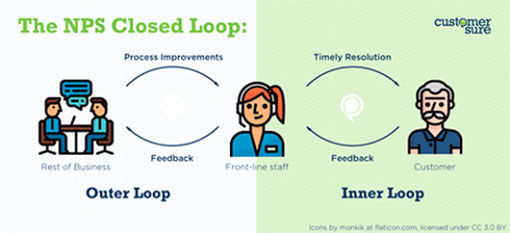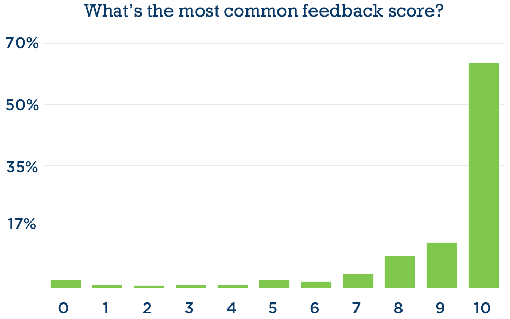Chris Stainthorpe of CustomerSure shares why he believes customer feedback should be a key part of your contact centre strategy.
Because you’re the sort of forward-thinking person who reads Call Centre Helper, you don’t need us to tell you that if something’s important, you’ve got to measure it.
Customer satisfaction is important, so we all try to measure satisfaction.
But there’s a problem.
Only a handful of businesses measure satisfaction in a way that improves it. In fact, many businesses actually manage to slightly decrease satisfaction by measuring it.
Surprisingly, that’s just one of the things we’ve seen go wrong with customer surveys.
We’d go as far as to say that fixing this is the single biggest missed opportunity in most contact centres. And based on our years of experience (in contact centres ourselves, and working alongside our clients), we’ve seen how to fix it.
How?
By getting feedback right: The right questions at the right time, with the right response.
Gathering and dealing with customer feedback alongside satisfaction scores shouldn’t be an afterthought. Getting it right it should be central to your strategy. Here’s why…
Getting Feedback Right…
Like anything else that’s worthwhile, you have put in a little effort to get it right. But the good news is, there’s a massive evidence base that shows that:
- It’s worth the effort
- You don’t need to reinvent the wheel – all the advice you need to succeed is already out there.
For instance
NPS is a fairly mainstream metric for measuring loyalty, but since 2011 (if not earlier), its creators have emphasised that it only works well when it’s used as part of a closed-loop system – where each customer who gives feedback is contacted if their comments merit it.

Or consider the experiences of our CEO, Guy Letts. In a former role as Head of Services at a massive international software firm, he turned a £1m revenue black hole into £1m+ profit by getting customer feedback right. Overall, because complaint volume dropped, and other initiatives could be shelved, it was a net effort-saving.
Or just consider your own experience as a customer. Just list the things a company you buy from could do to make you happier with them.
“A guarantee to listen to what I say, take it seriously and act on it” can’t be far outside your top three, can it?
So, Why Don’t More Firms Do It?
All the evidence – from sources as diverse as the authors of the NPS system to our clients who see this working every day, to your own experience – shows that getting feedback right is a potential game-changer.
We’ll look at the benefits of feedback in a moment, but first… If it’s widely recognised that good feedback is a good thing, why don’t more people do it?
Myth #1: It’s a Lot of Work…
Many people feel that they would love to ask customers for feedback and reply to it, but they’re a little… afraid… of what that actually entails.
They have visions of entire teams of agents tied up all day reading and responding to customer feedback. Or worse, having to hire new staff, making this a costly initiative.
In reality…
Getting feedback right saves work. At worst, it creates no extra work for a lot more reward.
You’re already doing a lot of things that aren’t “front-line customer service”: Your best agents coach other team members, you experiment with new initiatives like speech analysis (tying up agents whilst they interpret the results).
Getting customer feedback right:
- Reduces repeat issues, meaning call volume drops
- Improves agent performance
- Can eliminate or reduce other initiatives
- Reduces complaint volume
It’s a net time-saver.
Myth #2: Survey Fatigue
“Customers hate surveys!” – or so they say.
Yes.
Yes, yes yes. A thousand yesses. Customers hate bad surveys. They hate being treated as data points, dumped into a spreadsheet and squeezed out into a PowerPoint.
They despise 60-page, multiple-choice monsters, and frankly just cannot be bothered with pointless questions that no one is ever going to read the answers to.
They loathe IVR surveys with wonky speech recognition and have utter contempt for mails begging for a five-star Trustpilot review when no one’s even taken the time to ask them if their experience was OK.
However, if you take the time to build trust with customers that you’re listening. If you ask the right questions at the right time, and you get a reputation for following up efficiently…
…Then it turns out that customers don’t hate surveys at all. They love the opportunity to be heard.
Myth #3: Only Angry Customers Give Feedback
What’s the point in collecting feedback if you’re just going to have to listen to a bunch of whingers?
In reality…
We have a database of millions of satisfaction scores. We’ve crunched the numbers, and the overwhelming majority (over 70%) are praise.

Well, then! Most feedback is just kind words, so it’s not worth collecting!
We can see why you’d think that, but no:
i. Scores don’t tell the whole story. It’s perfectly possible for customers to give you a 9 or 10 on the NPS question but still mention problems. Being happy to recommend you doesn’t mean everything was perfect. You want to hear about problems so you can fix them twice – once for the customer giving the feedback, and once for every future customer.
ii. At least 5% of feedback is negative. That’s still a lot! Depending on how you define ‘complaint’, a score of ‘0’ is either a complaint, or a complaint about to happen. It might not be easy reading, but to improve satisfaction, you need to hear it.
iii. Most importantly, having your feedback taken seriously is a great customer experience. Even if all of your feedback was good (or bad), the fact that you’ve asked the right questions at the right time and responded accordingly will raise satisfaction – which is what we’re trying to do here.
Myth #4: AI Can Do All This for You
Software vendors are keen to sell AI-based solutions to most problems. Some of these solutions, when supported by good processes can deliver results.
But…
In their current state, they remain a nice tool to help with specific tasks, not a replacement for humans reading what other humans have to say and responding.
Secondly, even the best AIs struggle with the nuances of human speech. We’ve come a long way, but we’re still a long way from ‘perfect’ human-level understanding.
So, we definitely still need humans to watch the AIs and make sure they’re not misbehaving.
Just as importantly, how do we measure the success of an AI-based project? Do we set another AI to measure the results of the first… Or do we ask real customers what they think, and read what they’re telling us?
OK, I’ll give feedback a go. But you say it should be ‘central’… That’s a bold claim.
There’s a million things you can try to improve quality in a call centre. Half of them will also work.
But we don’t know of anything that delivers as broad a set of benefits as getting feedback right – especially for the minimal investment required.
Getting Feedback Right…
1. Makes your customers happier: the simple act of listening to people – really listening – makes them happier, more loyal customers, who spend more.
2. Is a great input for both quality assurance… you can spend three minutes listening to a call, and assess it based on your best guess of how the customer feels; or spend thirty seconds asking the customer what they think.
3. …and process improvement: You can try to convince internal stakeholders of the issues that customers are experiencing. Or you can let customers tell them, in their own words.
4. Improves your team: verbatim feedback is a powerful training tool. It connects with agents in a way that clipboards and management don’t. Moreover, it brings teams closer together: A ‘quiet’ agent can be secretly brilliant at solving tricky issues. Customer feedback proves their worth if they’re too shy to blow their own trumpet.
5. Makes attracting new business easier: a great reputation for service doesn’t hurt when you’re trying to attract new business. Nor does a database of verbatim customer comments telling your new business team exactly what you’re great at.
6. Simplifies compliance: an evidence base of real customer scores and feedback is a wonderful thing to be able to show regulators and auditors.
But Remember…
It’s not “doing feedback” that’s important. It’s Getting Feedback Right.
In a nutshell, that means:
- Asking customer-centric questions
- At a time that’s right for the customer
- And following up on what they say
The beauty of feedback is that it’s not a ‘bet the farm’ investment. You don’t have to commit to surveying every customer at every touchpoint in your business. You can be nice and agile with it.

Chris Stainthorpe
Spend 15 minutes working out what your customers would want to be asked. Tomorrow, send out a survey to a small set of customers at one touchpoint (perhaps post-call), and make sure someone deals with what they tell you.
If that goes well, add another touchpoint. Any issues, tweak the process and try again.
And so on. Until other teams are hearing about the brilliant results you’re getting from feedback, and asking for the secret to your success. Good luck!
Author: Robyn Coppell
Published On: 29th Oct 2018 - Last modified: 10th Dec 2024
Read more about - Guest Blogs, CustomerSure, Guy Letts





































